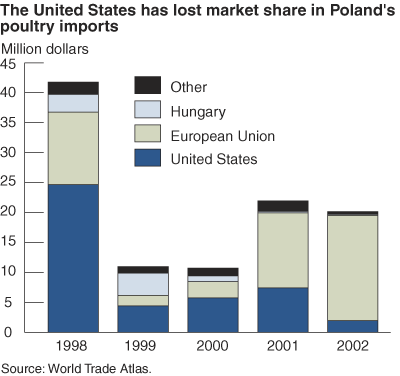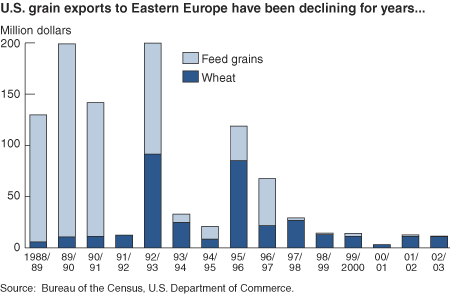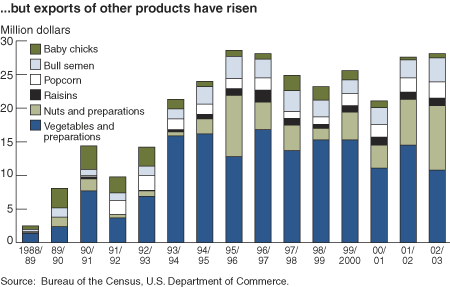A Historic Enlargement: Ten Countries Prepare To Join the European Union
- by Nancy Cochrane
- 4/1/2004
From the day the Berlin Wall fell in 1989, the governments of the formerly communist countries of Central and Eastern Europe (CEE) began to discuss the idea of joining the European Union (EU). In May 2004, after a 14-year transition from central planning to market economies, eight CEE countries (Poland, Hungary, the Czech Republic, Slovakia, Slovenia, Estonia, Latvia, and Lithuania), plus Cyprus and Malta, will join the EU. Bulgaria and Romania are also preparing for accession and are expected to join in 2007. In 2002, Croatia submitted its application for membership, and it is possible that Croatia, too, will be ready to join in 2007 (see box, “Who Are the Acceding Countries?”).
This enlargement of the EU, the largest in its history, will bring profound changes to Europe. The EU population will grow by 28 percent, with arable land increasing by nearly 40 percent. Grain area in the 10 candidate countries totaled 16 million hectares in 2000, nearly half the grain area in the current EU-15. The EU-15 is already a larger agricultural producer than the United States. The EU-25 will be an even larger presence on the global agricultural market.
Accession to the EU carries deep political symbolism for the citizens of the candidate countries. It will be a concrete signal to the world that these countries have finally broken free from their Communist past and rejoined Europe. East European voters approved accession in a series of referenda held in 2003, in the hope that membership would expand markets, raise incomes, and attract new foreign investment.
But many CEE farmers are apprehensive. In the early 1990s, many of them welcomed EU accession and the potential for higher prices and incomes. However, the expected financial gains will likely be limited by several factors. First, EU and CEE agricultural prices for many products have converged over the last decade. Second, CEE farmers will generally receive lower payments than their EU-15 counterparts. Third, though producers will receive direct payments from the EU, they will also incur the costs of complying with EU sanitary, veterinary, and animal welfare regulations.
CEE countries have already made several adjustments to their production and trade approaches in preparation for accession. As a result, the short-term impacts of enlargement on CEE and global commodity production and trade will likely be moderate. In the longer term, however, CEE producers may be forced to restructure their agriculture sectors to maintain competitiveness, which could lead to a significant rise in agricultural productivity.
EU Membership Will Bring Costs as Well as Benefits
Much has changed since the early 1990s, when most CEE farmers anticipated significantly higher incomes as a result of joining the EU. At that time, EU commodity prices were substantially higher than CEE prices, and EU farmers received generous income support. But the short-term benefits of accession will be less than initially expected, and CEE farmers have become increasingly aware that there will be costs as well.
Price gaps have narrowed. Over the past decade, the gap between EU and CEE prices has narrowed considerably, for a number of reasons:
- Exchange rates have changed. The currencies of the candidate countries have gradually strengthened against the euro.
- During the 1990s, CEE governments, in an effort to align their policies with those of the EU, began to intervene strongly in some markets, resulting in higher CEE prices. Poland maintains an aggressive intervention program for wheat, rye, sugar, and dairy products. Hungary and the Czech Republic, on the other hand, have supported their livestock sectors more than crops.
- For many products, the price gaps of the early 1990s reflected quality differences more than policy differences. Pork and beef prices reported by the EU are for the top three grades—in terms of lean meat content—of the EU grading system (known as EUROP). CEE statistical offices have historically reported average prices for all grades. Throughout the CEE, however, the average lean meat content has been increasing, and more pork and beef now meets the top three EU grades. CEE prices for pork and poultry are now, as a result, on par with EU prices.
- The EU itself underwent significant agricultural policy reform (see box, “The EU Common Agricultural Policy: A Decade of Reform”). In 1992, the EU reduced intervention prices (price supports) and introduced a system of direct payments to producers to compensate for the lost income. Agenda 2000, introduced in 1999, further reduced intervention prices.
CEE producers will receive lower direct payments per hectare than their EU counterparts. A major bone of contention during the accession negotiations was the level of direct payments that CEE producers will receive (see box, “The EU Common Agricultural Policy: A Decade of Reform”). The EU Commission realized that it would be impossible to provide the full range of direct payments to CEE farmers without violating the budget limits agreed upon in Agenda 2000. For this reason, the final compromise provides for a 10-year phase-in of payments. The EU will provide only 25 percent of the payments from the Common Agricultural Policy (CAP) budget during the first year; this share will increase by 5 percent each year until CEE farmers receive 100 percent of EU payments. However, national governments will be allowed to top off these payments by a maximum of 30 percent each year, so that payments during the first year of accession could be as much as 55 percent of what current EU farmers receive.
Direct payments will also be lower for CEE countries because of the way the payments are computed. Payments are tied to the yields associated with a reference period—1995-99—and to a reference area. Because of the disruptions caused by the transition from central planning to free markets, CEE yields during 1995-99 were substantially lower than those of the EU, which will keep CEE payment levels lower relative to EU payment levels.
CAP reforms approved in June 2003 will convert these payments to a single whole-farm payment between 2005 and 2007, so that they will be fully decoupled from production decisions. The reforms also call for additional direct payments to compensate for cuts in dairy prices. According to subsequent statements from the EU Commission, the whole-farm payment and all other new payments to CEE farmers will be phased in according to the same 10-year schedule.
The result is that per hectare payments received by the average CEE farmer during the first year of accession will be one-fourth the amount received by the average EU farmer. Payments will vary, of course, by country and by farm size. Small farms in Poland will receive less than 300 euros per year, while large farms in the Czech Republic or Hungary will receive as much as 40,000 euros ($1=0.8 euro).
Compliance with EU regulations will have costs. All the candidate countries must adopt the entire body of laws and regulations of the EU, known as the acqui communautaire. There are approximately 80,000 pages of EU laws and regulations relating to market regulation, veterinary and sanitary controls, animal welfare, and the administrative structures needed to implement EU price and income support programs.
To receive EU price and income supports, CEE producers will have to absorb the costs of this compliance. Grain producers, for example, will have to meet minimum quality requirements to receive the EU price. Livestock breeders will have to raise, transport, and track all animals according to the animal welfare regulations and recordkeeping requirements of the EU. All these measures will increase production costs, which will erode net returns of producers.
In addition, the administrative burden to acceding CEE governments will be considerably large, as agencies must maintain detailed databases on production, animal numbers, and other pertinent information for each farm that will receive EU payments.
Short-Term Impacts on Commodity Output Will Be Mixed
Given these facts, recent ERS analysis suggests that, in the short term, CEE output changes as a result of enlargement will be mixed. Enlargement is likely to lead to a substantial decline in wheat output by Poland, which currently supports wheat producers at levels higher than the EU, but wheat output in the other candidate countries will increase slightly. As a result, net wheat exports by the enlarged EU will likely be slightly less than combined net exports of the EU-15 and the candidate countries would be without enlargement. In contrast, CEE corn and barley output could rise dramatically.
CEE beef output is likely to increase significantly, since the EU maintains intervention prices for beef that are higher than current CEE prices. As a result, exportable surpluses in the candidate countries will grow. However, only small changes are expected in CEE pork and poultry output.
Under the current EU system of direct payments, farmers must produce grain and oilseeds in order to receive the area payments, and cattle breeders must maintain certain types of beef cattle to receive the beef premiums. Under the new system, which takes effect in 2005, farmers will only need to keep their land in “good agricultural condition.” They could convert their land to pasture, plant nothing, and still receive a payment; the incentive to increase output or produce anything is therefore reduced.
Enlargement Likely To Bring Short-Term Losses to U.S. Exporters
U.S. exports to Central and Eastern Europe will likely contract because CEE countries will have to adopt the stricter import policies of the EU. For example, the EU bans all poultry meat imports from the United States due to a ban on treating carcasses with chlorine. If this issue is not resolved, then all acceding CEE countries will also ban U.S. poultry upon accession.
But these losses will be small relative to those that have already taken place as a result of preferential trade agreements between the EU and the CEEs. In 2000, the EU signed “double zero” agreements with all the candidate countries, which provided duty-free quotas for pork and poultry trade and duty-free trade on a number of other goods. The “double profit” agreements signed in 2003 opened duty-free quotas for wheat, corn, beef, and dairy products, and allow nearly free trade in fruits and vegetables. So much of the CEE-EU trade is already completely liberalized, and this has reduced trade with third countries, including the United States.
During most of the 1990s, the United States was the principal supplier of poultry meat to Poland and the Baltic States. However, since the signing of the double zero agreement, the U.S. market share has been mostly supplanted by the EU. Remaining exports are mostly in the form of transshipments to the countries of the former Soviet Union, which will likely continue after EU enlargement.
U.S. grain exports to the CEEs also declined throughout the 1990s. In part, this is the result of a drop in CEE demand for feed grains as CEE livestock sectors contracted. In addition, Poland maintains a zero-tolerance policy for grain contaminated with ragweed seed, and U.S. grain shipments have not met that requirement. Also, many of the CEEs have barred im-ports of genetically engineered corn as they seek to align their policies with the EU.
Wheat imports by the enlarged EU are projected to rise slightly, but the United States may not benefit from that. Poland will be the largest net wheat importer after accession, and if Poland is forced to give up its ban on ragweed seed (the EU does not maintain such a policy), U.S. wheat exports to Poland might resume.
Even as U.S. grain exports have declined during the CEE transition period, exports of other products have grown. Significant among these are exports of nuts, raisins, popcorn, and other snack foods. CEE tariffs on most of these products will fall on accession, as the CEEs harmonize their tariffs with those of the EU, as will tariffs on wine, cigarettes, and tobacco. Rising incomes among the CEEs could stimulate increased demand for these products and lead to new markets for high-value U.S. products.
Future U.S. trade with the new member countries also depends on livestock developments. The United States is an important supplier of animal genetics (bull semen, baby chicks, etc.) to the region. Market access for these products will not change with accession, and opportunities could expand if CEE livestock producers seek to improve the genetics of their stock to become more competitive in the enlarged EU. ERS analysis suggests no immediate increase in EU imports of soybeans or meal. But demand for U.S. soybeans could expand in the longer term if the new members are able to expand pork and poultry production.
Longer Term Pressures for Restructuring
CEE agriculture employs land and labor, both plentiful, more intensively than does EU agriculture. Use of material inputs such as fertilizers, high-quality seed, and pesticides is lower, and capital is difficult to obtain. As a result, CEE crop yields are significantly lower than those in the EU (CEE grain yields averaged 2.3 tons per hectare in 2000, less than half the EU-15 average), and a higher share of labor is employed in agriculture. Accession will bring pressures for change from several sources.
The need to meet all EU standards and compete in a single market will bring significant pressure for restructuring of CEE agriculture and food processing. Farmers will need to meet EU quality standards or be barred from the market. Slaughterhouses will have to install equipment for measuring back fat, apply the EU grading system to all carcasses, and meet a formidable array of requirements concerning flooring, equipment, and separation of the “clean” from the “dirty” stages of processing.
These foreseen pressures have already led to investment and concentration in CEE processing sectors. Similar trends may emerge at the farm level. Smaller farms unable to meet the new standards will not be allowed to sell their products on the market and will eventually be forced out of business. This momentum toward farm consolidation could mean fewer, larger, and more capital-intensive farms and a reduction in demand for agricultural labor.
Uncertainty Remains
Overall, short-term impacts of EU enlargement on EU commodity output and world agricultural trade will not be nearly as large as once believed. In the longer term, accession can bring many benefits to the candidate countries. Consumer incomes will likely rise, and pressures for restructuring will lead to more efficient agricultural sectors in the CEEs.
At the same time, accession could bring hardship to many small farmers and processors in the CEEs. Processors that cannot meet strict EU standards will be forced out of business, and some farmers will see a deterioration in their net income. It remains to be seen how quickly the CEEs can generate new employment for those displaced from agriculture. So while a majority of CEE voters have embraced EU membership, much of the farming population remains apprehensive.
This article is drawn from:
- European Union. (n.d.). U.S. Department of Agriculture, Economic Research Service.
- Normile, M.A. & Leetmaa, S. (2004). U.S.-EU Food and Agriculture Comparisons. U.S. Department of Agriculture, Economic Research Service. WRS-0404.
We’d welcome your feedback!
Would you be willing to answer a few quick questions about your experience?




